Read the book first – if you can/dare. ‘Tis the spooky season!

Read the book first – if you can/dare. ‘Tis the spooky season!

Okay. Like a whole lotta people I binge-watched The Witcher last week.
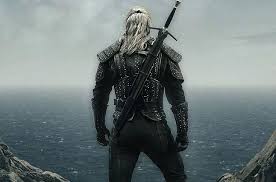
Filmed in Hungary, Poland, and Spain (I can almost hear the production location scouts saying stuff like, “Just give me a list of locations that are creepy AF!”) Netflix’s sword & sorcery offering does its level best to fill the hole left in some of us following GoT’s exit.
The Witcher manages to check all the right boxes for a fantasy series.
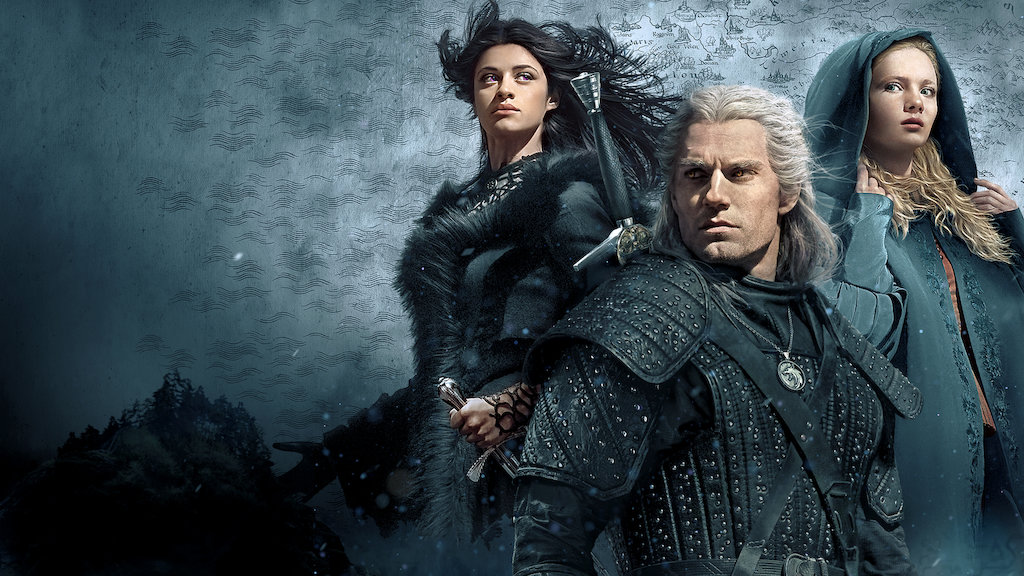
What’s not to love?
Okay, the writing. Almost every episode is penned by a different scribe, but I’ll put this one on creator Lauren Schmidt Hissrich, who provided the scripts for the first and final episodes. The writing isn’t bad, but the story structure is a tad cumbersome. Those of us unfamiliar with Andrzej Sapkowski‘s book series of the same name, spend the first handful of episodes playing catch-up until we realize that we’re being told three different overlapping stories that aren’t happening at the same time. Once that mischief is managed, however, it’s pretty much smooth sailing into pure escapism. Cue the hacking!
EVERYONE is swooning over British actor Henry Cavill, who lucked into the titular role of the series. There’s a reason for that. Dude is hot as hell AND he can act. He also looks amazing in black leather. If you’re missing Viggo or Kit, Henry just might make you forget your pain for a bit.
But there are other standouts in this sprawling cast.
Anya Chalotra (who also looks amazing in black leather) is riveting as the very complex Yennefer. MyAnna Buring goes the extra mile as an actress and then some in her ardent portrayal of Trissaia, the cruel-to-be-kind headmistress of Aretuza, and Jodhi May totally brings it as the powerful but tragically prideful Queen Calanthe. There’s a lot of delightfully diverse woman-power in the cast, which I can only hope serves to light a fire under everyone else’s asses.
The Witcher’s production values range from “eh” to “wow!” The costumes absolutely fall into the latter category. British costume designer Tim Aslam did a magnificent job clothing his cast, and all I can say is that Anya Chlotra must be particularly pleased. The CGI budget (saved mostly for the last two episodes) was well spent, and delivered bang for buck, for the most part. Sonya Belousova’s score is fine. And no one will ever complain about any episode in this season being underlit.
Of particular note is the creation of The Witcher’s own school for Witchcraft and Wizardry…well, just witchcraft, I guess: Aretuza. A cruel and frightening place where you either succeed, or your life essence is taken and used to power the joint. Survival of the fittest at its scariest. Production Designer Andrew Laws and team got Aretuza just right, and it is, in my opinion, the most striking setting in the series.

A lot of what goes on in The Witcher borders on the nonsensical, but oddly, that only seems to add to the overall derring-do of the project. The epic gravitas of tales like LoTR and GoT is definitely missing here, but there is something unique about each character in The Witcher, which provides some internalized gravitas for the viewer.
The story is compelling, the acting is solid, the visuals are solid…its FUN, damnit, FUN.
So, if the dark nights of winter seem darker for want of a rollicking fantasy yarn with most of the bells and whistles you’ve come to love, give The Witcher a try. It sucked me right in, and I hate everything.
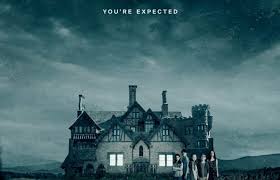
Stephen King, who kinda knows his shit when it comes to horror, declared Shirley Jackson’s 1959 novel, “The Haunting of Hill House” one of the “most important horror novels of the 20th century.” I’ll see Mr. King’s assessment and raise it to one of the most important novels of the 20th century, period.
Those of us of a certain age who love horror, had already been thoroughly terrified by writers like Lovecraft and Jackson before King blew into town, and indeed, “The Haunting of Hill House” remains, for millions, the consummate tale of a haunted house.
Who could guess that terrors unimagined awaited readers inside such a harmless looking book?
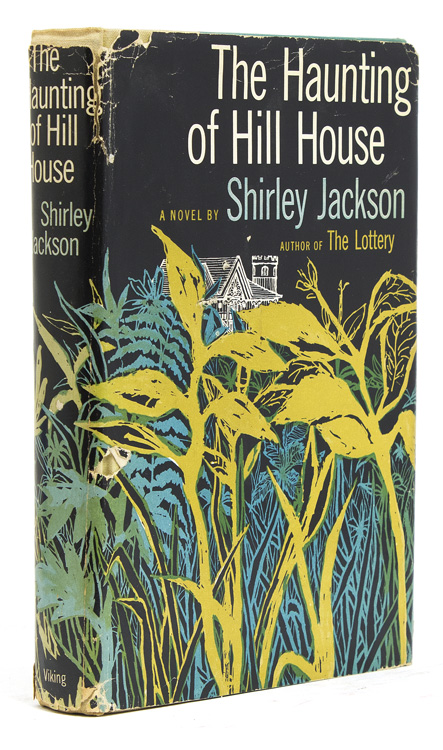
It’s as though the artist couldn’t bring her or himself to present Hill House in more than an outline form and then covered it with a jungle’s worth of foliage, lest the house notice the effort and…object.
Shirley Jackson’s place in the pantheon of horror masters was won fair and square, and “The Haunting of Hill House” remains the haunted house story by which subsequent efforts are judged.
Why, oh why, then, did Amblin Television/Paramount Television and producer/writer/director Mike Flanagan conspire to take this pristine example of American Gothic literature and crap all over it? And why did Netflix take a look, shrug its corporate shoulders and say, “Yeah, sure why not?”
There be spoilers ahead, matey.
If you’ve already watched this catastrophe and loved it, just…go away. If you haven’t watched, but are planning to because you love Jackson’s book, or Robert Wise’s perfect 1963 film adaptation, go back! If you’re determined to proceed, beware.
Jackson’s creepy and ultimately terrifying Hugh Crain, whose titanic personality infests every inch of the house he built for a wife who would never set foot inside the monstrosity…alive…has been morphed by Flanagan into an oddly jejune flipper of houses played to perfection as a young father by Henry Thomas.
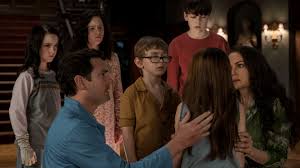
And played to equal perfection as the older, world-weary and perennially haunted, PTSD survivor by Timothy Hutton.

A flipper of houses? Yes, dewy-eyed Hugh and his somewhat wifty wife, Olivia (the excellent Carla Gugino) have somehow acquired Hill House which they intend to renovate (over a mere summer!) and sell for YUGE money. I guess Mr. Flanagan forgot what happened to real estate in the ’90’s.
The entire re-imagined Crain clan, which includes Hugh and Olivia’s five children, Steven, Shirley (!), Theodora, Luke and Nell, move into Hill House and the haunting begins.
Flanagan’s story toggles back and forth between then and now. Then, he focuses on the children’s experiences in the house, and now he focuses on what those experiences have produced. Luke has become a heroin addict. Shirley has become a mortician. Steven has become an author of books about hauntings. Theo has become a child psychologist. Nell has become a widow. Hugh has become estranged from his family, and Olivia has become dead.
Every episode alludes to the terrible events of the family’s last night in Hill House in which Olivia’s life was claimed by the spirits that literally prowl the carpeted corridors with abandon. By the time I groggily fired up the final episode and observed Flanagan’s big reveal, my only response was: Oh.
Here’s the deal: Jackson’s story was so freaking terrifying because you never SAW anything. You heard things, disturbing things. Who could ever forget the pounding on the walls? “God! Whose hand was I holding?” remains one of the scariest lines ever committed to paper. (Spoiler: Flanagan decided we need to SEE the ghostly hand in question. Sigh.) Jackson’s characters THOUGHT they saw things, out of the corners of their eyes. The phantom black dog that leads half the group out of the house on a chase, leaving the real Nell and Theo alone and ripe for an epic ghostly encounter. The breathing doors…I’ve literally got goosebumps. Jackson knew that the suggested unknown is what really wriggles into our hypothalamus and gets it to command our adrenals to start blasting out cortisol and adrenaline.
Not so with Mr. Flanagan, who has populated his Hill House with an army of corporeal ghosts, some straight out of the Asian horror film handbook, and some from Mr. King’s inviolate cabinet of spooks. Some are menacing, and some are just silly. But poor Hill House is lousy with them. Here’s the kicker: if you don’t LOOK at them, they’ll pretty much leave you alone, so just pull those covers over your heads, kids.
A word about the Dudleys.
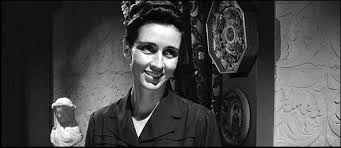
Mrs. Dudley gave birth to every single crazy old man or woman who warns the Scooby Gang not to proceed. As created by Jackson and portrayed by the great Rosalie Crutchley in 1963, Mrs, Dudley convinces us from the beginning to GET OUT. Her husband, Mr. Dudley is a nearly silent presence of menace. Flanagan decided that the Dudley’s needed reinvention. His Mrs. Dudley, played by the always amazing Annabeth Gish, is a kindly soul, who happily interacts with the family, while her husband is a somewhat goofy aged hippie who is also always around to lend a hand. In one scene, Gish is placed front of an angel statue so it appears that the celestial wings are actually hers. Flanagan, you bastard!
Anyhoo, Flanagan plucks elements from Jackson’s novel like the last vulture to arrive at the rotting corpse. He takes unforgettable lines and moments and tosses them into his word salad teleplays to whatever character can catch them. He averages 2.5 thoroughly horrible theatrical monologues per episode. His characters are completely uneven, and most are just cyphers. Nothing about the family Crain is ever truly explained, leaving us with overly drawn out examinations of moments in characters’ lives that have little to zero interest because so much is missing from their backstory. We know WHAT they are, not WHO they are.
But Flanagan’s biggest crime was his casual omission of the main character in Shirley Jackson’s story: Hill House.
Jackson’s Hill House is a living breathing entity. It sits in the New England forest, waiting, patiently. It allows the Dudley’s to keep it running – during the day – and it keeps it’s own counsel during the night…in the dark. Hill House is often portrayed by artists as having eyes, so palpable is its personality. A house born bad and now ruled by a single entity: Hugh Crain. Hill House is larger than life…
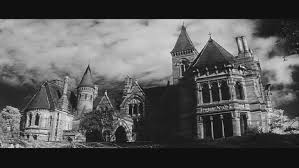
…and it certainly isn’t something that a house-flipper would buy and renovate in a freaking SUMMER. As described, Hill House is at LEAST 8,000 square feet, probably closer to 10. It would takes YEARS to renovate such a beast. Flanagan’s Hill House is merely a work in progress. There’s black mold to contend with. Windows to replace. Blueprints to create. It’s a container of spirits, but is, itself, without life. And therein lies the ultimate shame of this truly terrible adaptation.
That, and Flanagan has – for whatever reason – provided his adaptation with a relatively HAPPY ENDING which plays over COUNTRY WESTERN MUSIC. What the literal fuck? AND he has decided in his delusional hubris to change one word of Jackson’s final line that morphs the entire project into a treacly salmagundi as usually found in more wholesome fare like, “This is Us.”
The acting is superb. The scripts suck (especially those monologues). The production design is a boring monochromatic mush. (I smell Tisch grads.) The omnipresent video flare (which prevents true black) is unforgivable. The acting is superb.
Mike Flanagan: you suffer from the presumption of interest. I suggest you make a pilgrimage to Shirley Jackson’s grave in Vermont (in which she’s still spinning, trust me) and apologize.
‘Tis the season. I highly recommend watching or rewatching Robert Wise’s faithful 1963 adaptation, staring Julie Harris and Claire Bloom for real scares that stay with you. And no matter what Mike Flanagan says, Hill House remains a solid part of our collective unconscious. It’s that inexplicable place that is just bad because it was always meant to be bad. And whatever walks there, walks ALONE.

I spent a good portion of New Year’s Day binge watching this haunting Netflix docudrama. Directed by Errol Morris of “Thin Blue Line” and “Fog of War” fame, “Wormwood” is a unique and truly frightening journey into post-WWII America in which maniacs at the CIA were busy developing what would eventually become MKUltra. What’s a little LSD between friends, right?
When Army scientist, Frank Olson, mysteriously flew out of his window at NY’s Statler Hotel in November of 1953, his death presented his young son, Eric, with a Quixotic life’s quest: to find out what really happened to his father.
The episodes cut between chilling and tragic interviews with Eric, and exceptionally atmospheric dramatic scenes as imagined by Morris. Peter Sarsgaard’s Frank Olson is a perfectly crafted cypher, challenging us to wonder if ANYONE actually knew this man, let alone his family. Also turning in wondrous performances are Tim Blake Nelson, Molly Parker, a totally sinister Jimmi Simpson and the much beloved Bob Balaban.
The documentary scenes are filled with heartache and the kind of despair that allows us to glimpse beyond a stranger’s event horizon to the black hole that has begun to devour them. If the story being told wasn’t so monumentally important, I doubt I could have finished watching.
Perhaps one of the most tantalizing scenes in the series was an interview between Errol Morris and American journalist legend, Seymour Hersh.
No longer the swaggering young hero who exposed the My Lai Massacre and nabbed the 1970 Pulitzer, Hersh has morphed into the Fourth Estate’s Jabba the Hut, not in size but in attitude. Puffed-up with comfort and hubris, Hersh dismissively stares down Morris and then smugly assures him that he knows exactly what happened to Frank Olson in 1953. Of course he can’t spill the beans because that would allegedly jeopardize his source. Hersh definitely believed that he was totally owning Morris, but he foolishly forgot that the cameras trained on him belonged solely to the filmmaker. Oops, Seymour! Your callous pomposity is now forever preserved in an age when we’ve come to treat journalists like snakes that we can’t immediately identify as being venomous.
If you’re turned on by riveting documentaries, moody murder mysteries, great performances, the Cold War, CIA skullduggery, MKUltra, and genuine human pathos – the kind that makes you question pretty much everything – then I highly recommend “Wormwood.”
It’s a slow burn, but once the fire finally catches, you simply can’t look away. And if you’re wondering about the title, check Revelation 8 verse 10.